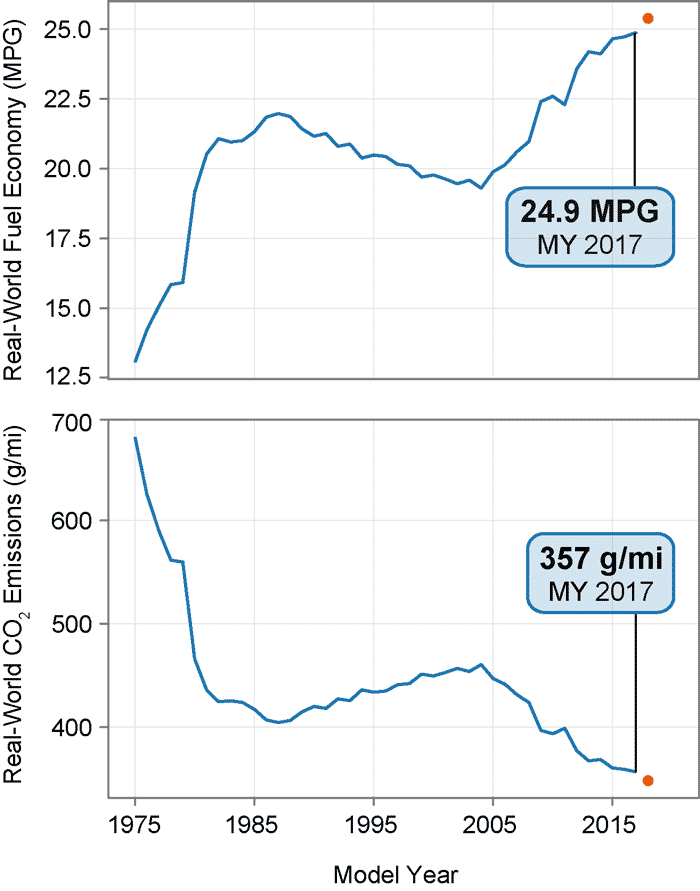

Cars make their way their way over the East River on the Robert F. Kennedy Bridge into Queens on Feb. 25 in New York City. JOHANNES EISELE / AFP / Getty Images
For new cars and trucks released in 2017, carbon dioxide emissions reached a record low, and mileage per gallon reached an all time high, according an U.S. Environmental Protect Agency (EPA) report released Wednesday.
The findings are leading many environmental advocates to ask, if Obama-era fuel economy standards seem to be working, why roll them back, as Trump’s EPA has proposed?
“The EPA’s report demonstrates that standards are working to bring us cleaner, more efficient cars,” Natural Resources Defense Council (NRDC) Clean Vehicles and Fuels Group Director Luke Tonachel wrote. “There’s no reason to turn back. The Trump administration’s plan to rollback the standards will cost Americans more at the pump and make us all suffer from increased vehicle pollution. We should keep the current strong standards and look forward to more positive progress reports in the future.”
The EPA data shows that the average real world carbon dioxide emissions rate for new vehicles released in model year 2017 fell by 3 grams per mile (g/mi) to a record low of 357 g/mi. Fuel efficiency climbed 0.2 miles per gallon (mpg) to 24.9. Since 2004, both fuel economy and carbon dioxide emissions have improved in 11 out of 13 years.
Manufacturers expect to do even better in 2018, lowering emissions to 348 g/mi and raising fuel economy to 25.4 mpg.
Estimated emissions and fuel economy for model years since 1975. 2018 projections are shown with the red dots.EPA
The EPA’s data also acknowledged that both fuel economy and greenhouse gas emissions had improved significantly since tougher standards were put in place in 2012. In that five year period, the industry lowered emissions by 21 g/mi and improved fuel economy by 1.3 mpg. That amounts to saving customers more than $65 billion in gas money and keeping 325 million metric tons of climate-change causing carbon out of the atmosphere, NRDC reported.
EPA data also shows how individual manufacturers performed in that five year period. Subaru led the industry in reducing emissions and improving fuel efficiency over the entire five years, while Honda performed the best in most metrics in 2017.
How major car makers performed in terms of reducing emissions and improving fuel economy from 2012 to 2017EPA
Despite the apparent success of fuel efficiency standards, newly-confirmed EPA Administrator Andrew Wheeler still used the report to justify his plans to lower them. That is because most manufacturers used credits from over-complying in previous years, along with technological innovation, to comply with standards in 2017.
“Today’s report shows that while the auto industry continues to increase fuel economy, there are legitimate concerns about the ability to cost-effectively achieve the Obama administration’s standards in the near future,” Wheeler said in a news release reported by Bloomberg.
However, for Union of Concerned Scientists Senior Vehicles Analyst Dave Cooke, the use of credits sent a different message, as he explained:
Automakers will be entering the 2018 model year with more than 249 million metric tons (MMT) of CO2 credits, thanks to doing better than required in previous years. While they’ve had to use some of these credits again this year, the industry used less than last year (18 MMT worth vs 30 MMT). That’s because automakers improved their fleets in 2017 at a rate greater than required, which helps illustrate the year-to-year variance in model updates and the way in which banked credits are planned as apart of an overall compliance strategy.
To put that 249 MMT of banked credits in context, manufacturers could actually do absolutely nothing to improve the efficiency of their vehicles until 2020 and still continue to comply with the standards.
Both Cooke and Tonachel argued that lowering standards would hurt innovation. Cooke said that the report showed that most companies had only invested in a few of the possible technologies to improve their fuel efficiency, indicating that there was ample room for improvement. If fuel efficiency standards are maintained, gas-powered vehicles could reach an average of 36 mpg on by 2025 using existing technologies, Tonachel wrote.
“Rolling back the standards will only disrupt innovation and leave drivers with higher fuel bills,” he said.

 233k
233k  41k
41k  Subscribe
Subscribe 

